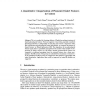Free Online Productivity Tools
i2Speak
i2Symbol
i2OCR
iTex2Img
iWeb2Print
iWeb2Shot
i2Type
iPdf2Split
iPdf2Merge
i2Bopomofo
i2Arabic
i2Style
i2Image
i2PDF
iLatex2Rtf
Sci2ools
CONTEXT
2005
Springer
2005
Springer
A Quantitative Categorization of Phonemic Dialect Features in Context
We test a method of clustering dialects of English according to patterns of shared phonological features. Previous linguistic research has generally considered phonological features as independent of each other, but context is important: rather than considering each phonological feature individually, we compare the patterns of shared features, or Mutual Information (MI). The dependence of one phonological feature on the others is quantified and exploited. The results of this method of categorizing 59 dialect varieties by 168 binary internal (pronunciation) features are compared to traditional groupings based on external features (e.g., ethnic, geographic). The MI and size of the groups are calculated for taxonomies at various levels of granularity and these groups are compared to other analyses of geographic and ethnic distribution. Applications that could be improved by using MI methods are suggested.
| Added | 26 Jun 2010 |
| Updated | 26 Jun 2010 |
| Type | Conference |
| Year | 2005 |
| Where | CONTEXT |
| Authors | Naomi Nagy, Xiaoli Zhang, George Nagy, Edgar W. Schneider |
Comments (0)

